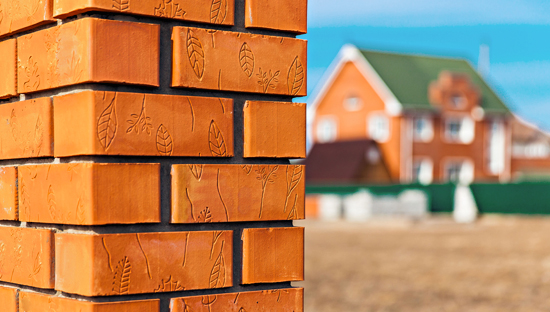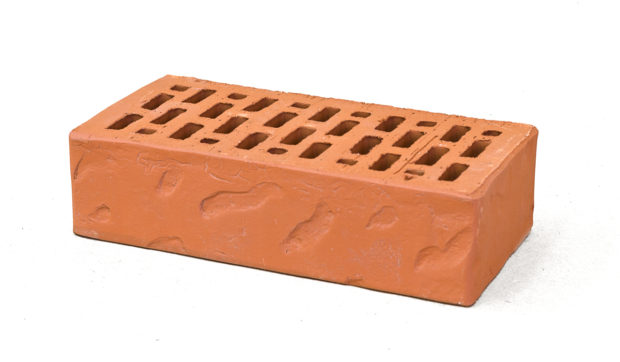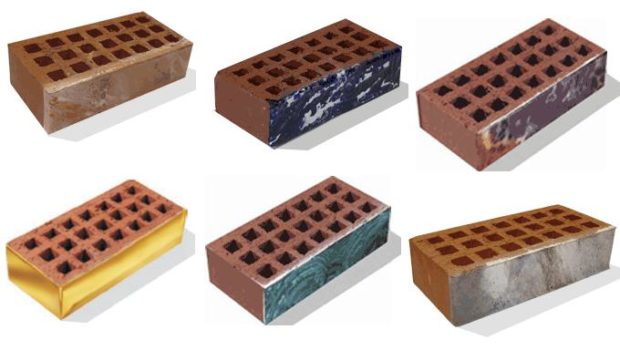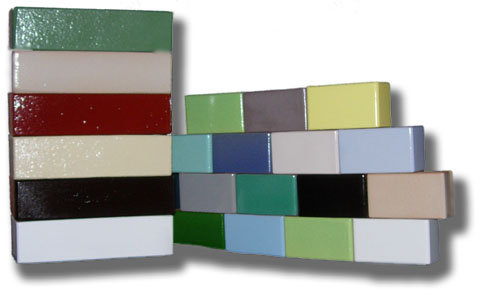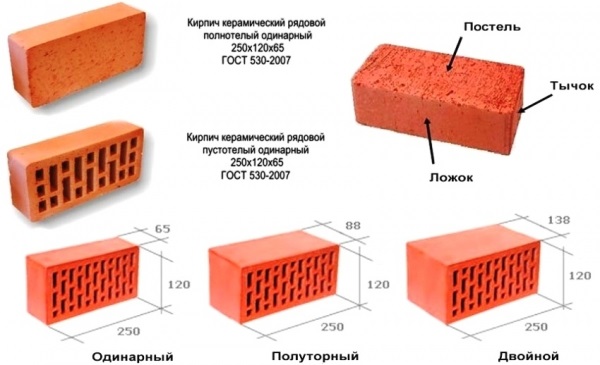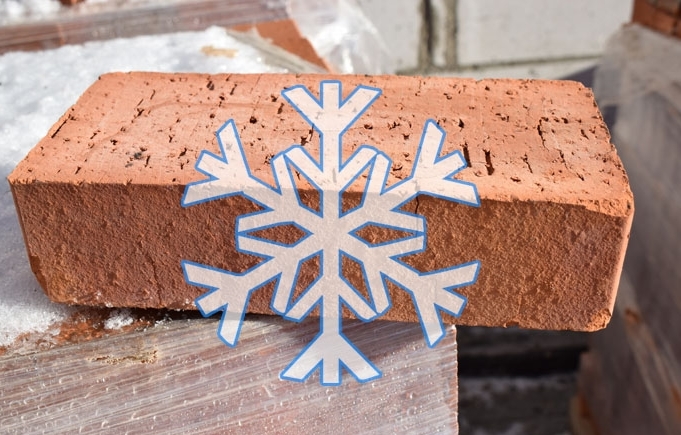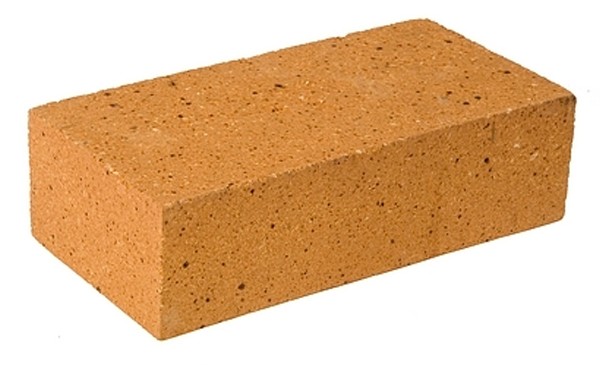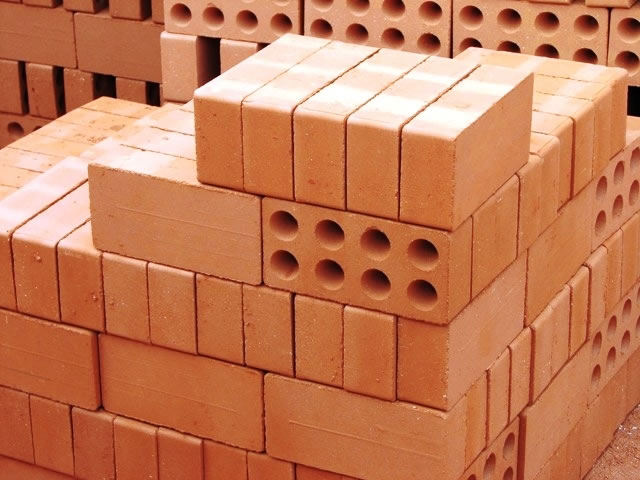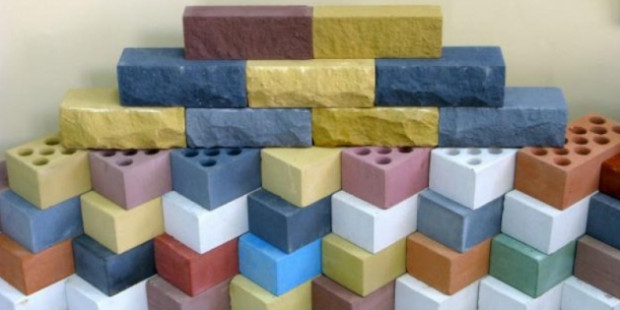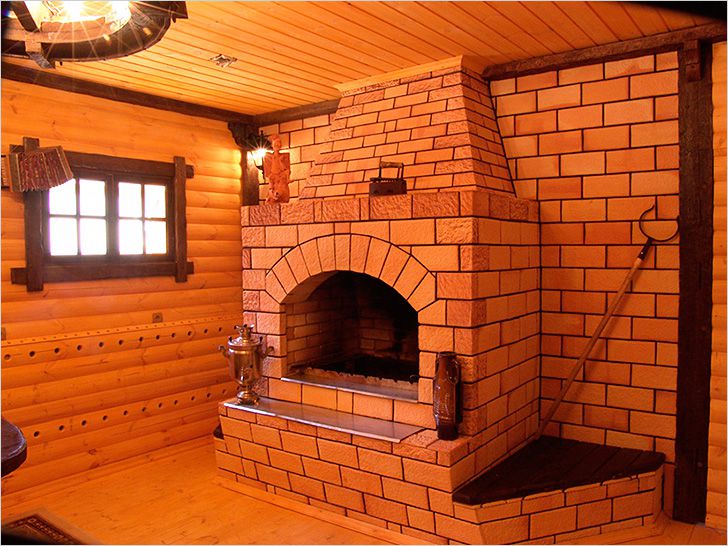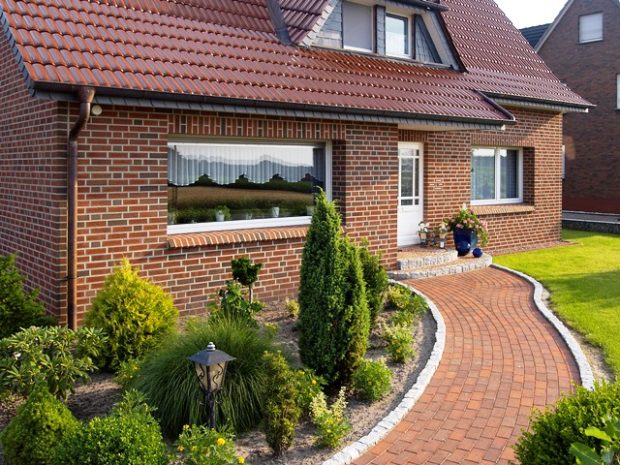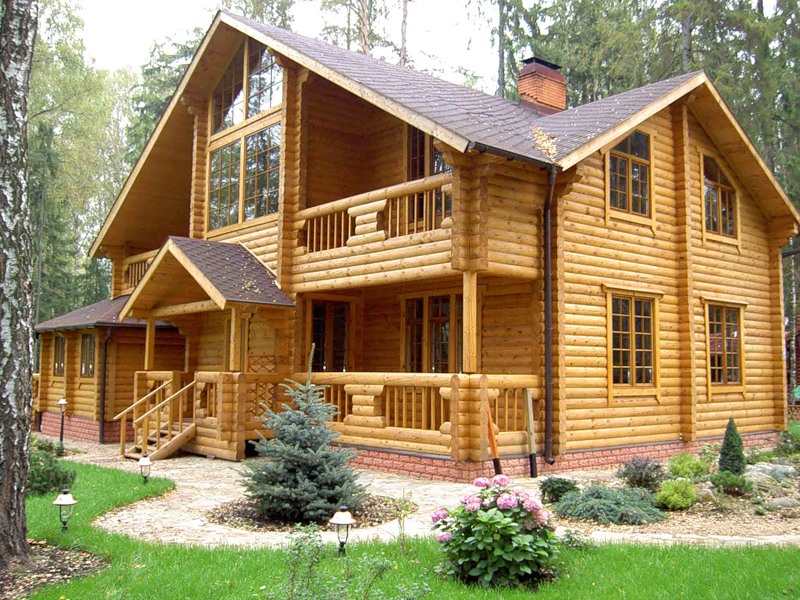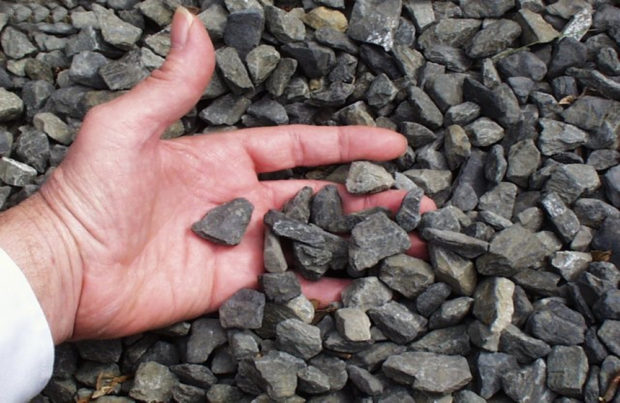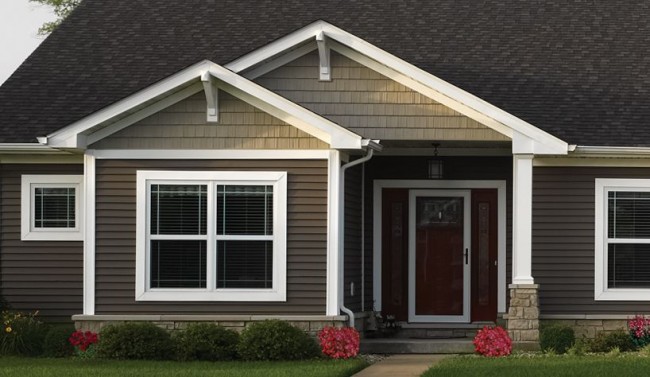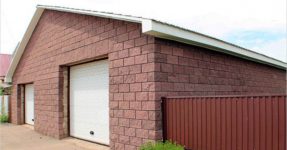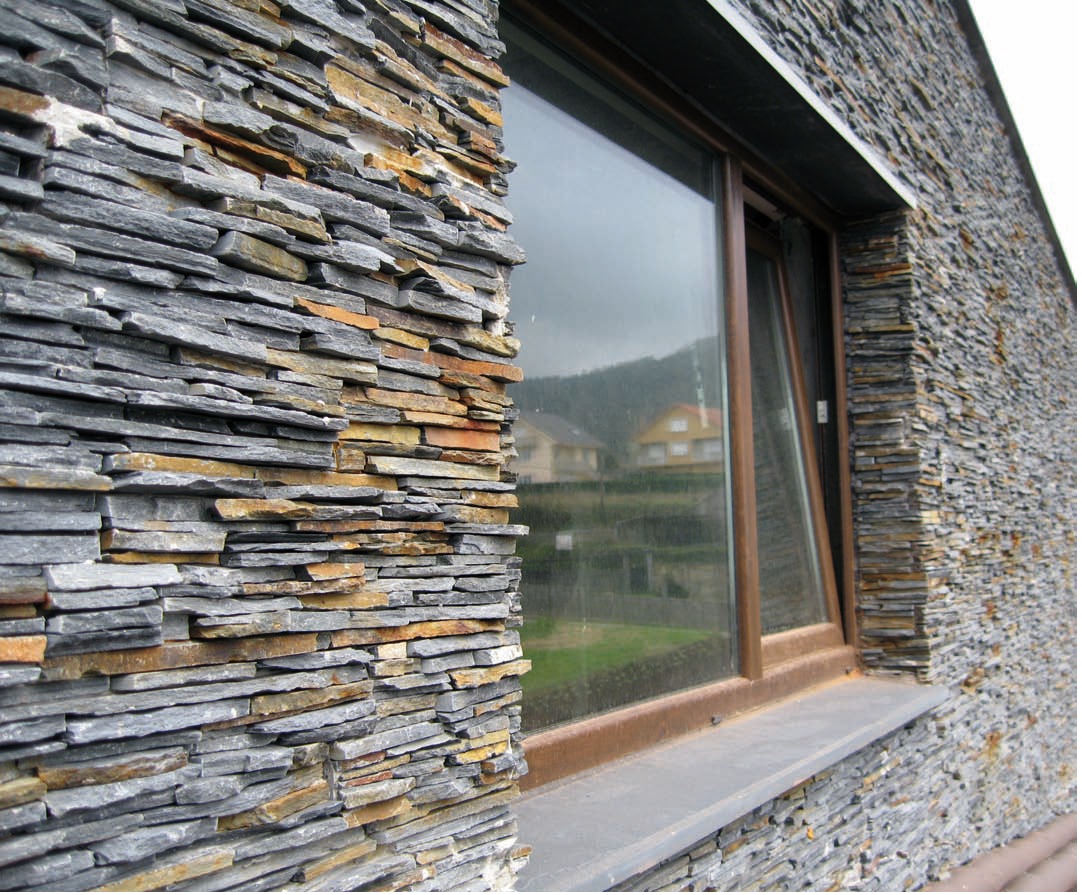Red brick: features and selection tips
It is difficult to find a material more popular in construction than red brick. Houses and fences, foundations and garages are erected from it. Ceramic brick bribed the whole world with strength, durability and environmental friendliness. Another advantage of the material is variety. From full-bodied and hollow, ordinary and facing bricks, you can build and decorate any buildings. The main thing is to choose the right red brick and carefully examine its characteristics.
Production Features
Red brick can be called a strategic material, so the process of its production is strictly regulated by national standards. Today they are guided by GOST 7484-78 and GOST 530-95. According to regulatory documents, clay with a minimum content of marl and sulfates is used as raw material. Mining is carried out in an open way, and brick factoriesmainly located near deposits. As a rule, clay has a reddish hue, so the finished material is called red brick, although its official name is ceramic brick. During the production process, colored pigments can be added to the mass, and then the finished brick will have the wrong terracotta color. The shade of the product depends heavily on the characteristics of the raw materials, so from the clay obtained in different deposits, bricks of different colors are obtained.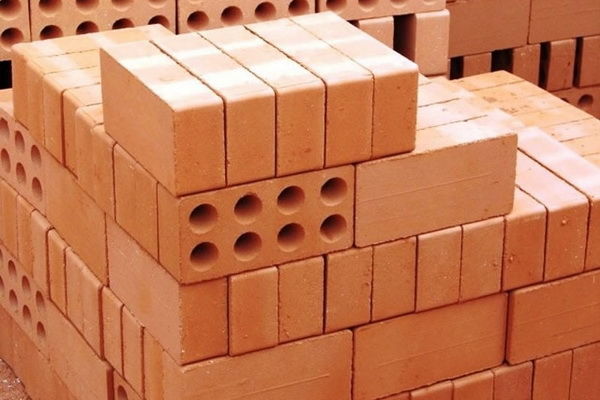
Clay mass is formed on tape presses, and the uniformity of the composition and the absence of voids is achieved through the use of vibrating stands. Then follows drying and firing. Raw bricks are dried by chamber or tunnel method. The first option involves drying the workpieces in a room where the parameters of temperature and humidity change in the required sequence. The tunnel drying method involves the passage of raw trolleys through zones with different microclimate. The result is almost the same.
The mass is fired in furnaces at temperatures of 950-10500FROM until part of the vitreous phase in the product reaches the level of 8-10%. It is with these parameters that the brick acquires the best strength indicators. Properly Burnt Brick gives a clear sound when struck and has a reddish-brown hue. If it is not burned, the color will be closer to mustard, and the sound upon impact will be deaf. Burned brick can be recognized by the fused edges and dark core.
The properties of the finished brick also depend on which formation method was chosen:
- plastic forming method involves the manufacture of bricks from clay mass with a moisture content of 15-30%. The product is obtained by extrusion. Vacuum plants are used to produce hollow samples. Billets are dried in a chamber and burned in furnaces or tunnels. This brick is more frost-resistant and recommended for building a house;
- dry and semi-dry method of formation. In this case, clay mass with a lower moisture index (about 7-12%, it all depends on the particular production) is used, raw brick is made of it by pressing under pressure up to 15 MPa. Drying is absent altogether or is present in an abridged version. The final stage is firing.In terms of performance, such a brick is slightly inferior to a brick of plastic molding, but differs in more accurate geometry. In this way, facing ceramic bricks are usually produced.
Ceramic brick is used when laying foundation, in private construction during the construction of load-bearing walls and partitions, outbuildings and garages. The facing type of brick found wide application in facade decoration, and also sometimes used for interior decoration.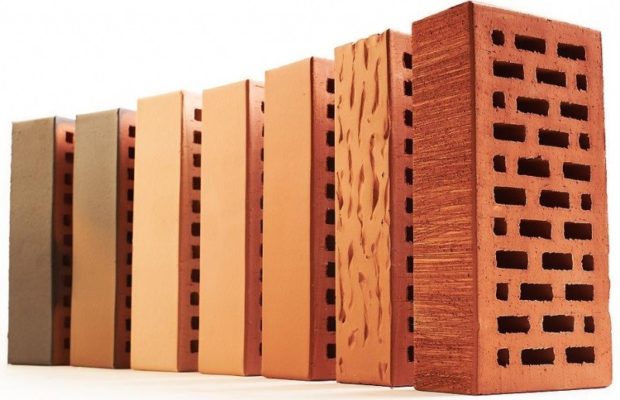
Advantages and disadvantages of ceramic bricks
The raw materials used for the manufacture of red bricks, and the production technology itself allow us to talk about the mass advantages of this material:
- environmental friendliness. The composition includes almost one clay, and this is a natural raw material;
- aesthetics and variety. The market offers a wide range of red bricks of various sizes, shapes and colors. The facing brick can have a relief surface, so that any idea can be realized;
- excellent heat and sound insulating qualities;
- high level of resistance to negative atmospheric (sun rays, frost, moisture, temperature changes) and biological factors (fungus);
- durability;
- fire resistance;
- relatively affordable price.

Significant disadvantages the material does not have, except that its weight is solid, so you have to take care of creating a solid foundation, but it's worth it. Sometimes builders complain about insufficient material durability or inaccurate geometry, but all this is due to violations in production technology. To buy high-quality brick, it is better to take it from trusted and reputable manufacturers and sellers. Residents of the Central Federal District can recommend the products of LLC Kashirsky brick factory, located in the village of Ozherelye, Moscow Region. Kashira brick is produced using raw materials from our own deposits, which allows us to monitor the quality at all stages and offer our customers the lowest prices.
Private and front brick
Depending on the scope of use, ceramic brick is divided into two types:
- ordinary, he is construction or ordinary;
- front, or facing, or front.

Building brick used to create the foundation, the construction of load-bearing walls and partitions. Small chips are allowed on it, but the geometry of the samples must be accurate. After the construction of the walls and partitions, ordinary brick requires facing. The material is usually made full-bodied, but there are also hollow samples - they are going to create curtain walls. It can be single, one and a half, double, etc. in size, we’ll talk about this separately.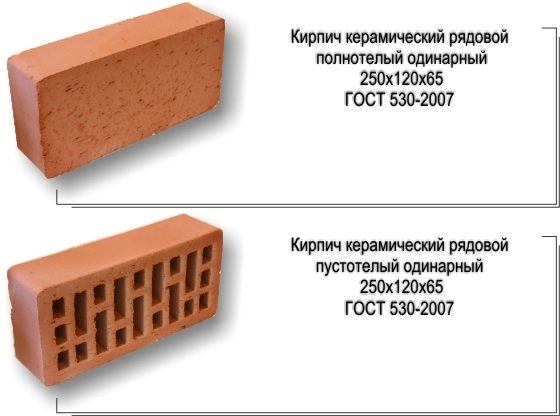
Front brick more interesting in terms of diversity. It is used for facade decoration, can be used in interior decoration. As a rule, these are hollow bricks that weigh less and are characterized by improved thermal insulation qualities. Facing brick must have accurate geometry and uniform color. As for the shade, the natural color of ceramic brick is quite beautiful and noble, so you can not even look towards the tinted samples. If you want something original and extravagant, you can find color brick. Staining is carried out in bulk by adding pigment, so that the original shade will remain for a long time.
Facing brick differs not only in color, but also in the type of surface. In the simplest version, it will be perfect smooth, possibly with bevels. This is a traditional and proven option. If you wish, you can move away from the classics and choose one of the following surface types:
- embossed. At the desired end of the still unfired brick, a three-dimensional pattern is formed using a stencil. After processing in the furnace, the pattern remains, while the strength of the brick does not change at all;

- engobed. An engobe, a layer of ceramic mixed with metal oxides, which are responsible for creating a certain shade, is applied to the dried, but still unbaked brick. In an oven, under the influence of high temperatures, the engobe is fused with a clay mass of bricks. The result is a holistic durable product with an interesting shade. Engobe is sometimes applied only to a part of the butt, forming a spectacular color transition;

- glazed. If glaze is applied instead of engobe, then in the end you can get a brick with a smooth shiny surface, which has not only excellent aesthetic qualities, but also additionally protects the material from moisture.

Facing bricks are produced not only in the standard form of a parallelepiped - a wide assortment of figured brick. It can have rounded corners, cutouts and waves, wedge-shaped, trapezoidal and many other samples are found, the shape of which is difficult to describe. These elements are necessary for the effective design of window and doorways, corners and floors of the house.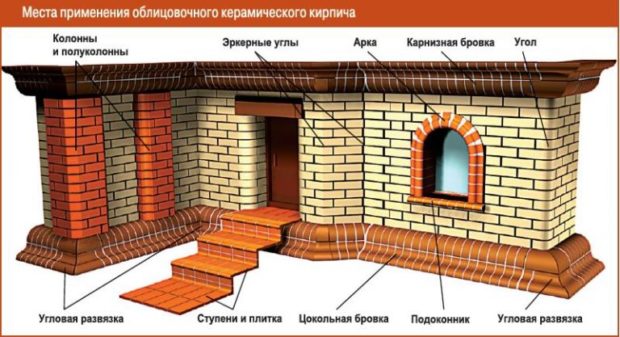
Hollow and corpulent brick
The performance of a brick is largely dependent on the type of its internal structure. Ceramic bricks can be solid and hollow. Corpulent, as the name implies, does not contain voids and has a minimal number of pores. Due to this, excellent indicators of strength and frost resistance are achieved. Solid brick is necessary to create foundations and load-bearing walls. The absence of pores and holes leads to high thermal conductivity, so a full-bodied ceramic brick must be insulated without fail. As a rule, ordinary brick is made full-bodied, but full-body facing products are also found.
To reduce weight, save raw materials and increase thermal insulation qualities, holes are made in the mass. They can be round, rectangular or slit-shaped, located vertically or horizontally, be through, or be closed on one side. Some of these holes in ceramic bricks sometimes reach 45%.
Hollow brick used for masonry partitions, less often - when creating lightweight external walls. An exception is a brick with horizontal voids, it can not be used when laying bearing walls due to its low mechanical strength - under weight it can simply deform and break. Typically, facing bricks are made precisely in a hollow design.
Separately, we note porous brick, in which, in addition to holes, there are also pores. They are obtained by adding a mixture to the clay mixture and burning the latter during processing in the furnace. Enough large pores remain in the mass, which become the key to improved thermal insulation qualities. Porous brick has large dimensions, walls are very quickly erected from it, and the level of thermal conductivity of the material almost approaches foam concrete, wood and gas silicate. In such a brick there are special channels where vertical reinforcement is poured. This technology allows you to build warm homes in seismically hazardous areas.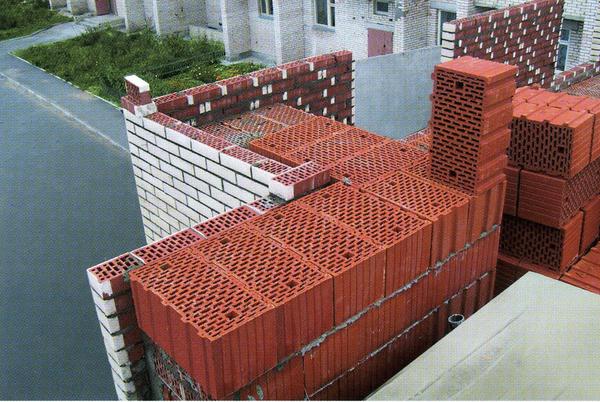
A parameter such as density. For a full-bodied brick, it reaches 1600-1900 kg / m3and for the facial is approximately 1300-1450 kg / m3.
Brick size
In construction, it is customary to focus on dimensions standard (single) brick. This is a parallelepiped-shaped block with dimensions of 250 * 120 * 65 mm. A huge part of ordinary and front bricks is produced in this format. In addition, on sale you can find bricks of other sizes:
- one and a half brick, 250 * 120 * 88 mm, can significantly save time when laying massive structures;
- double brick, 250 * 120 * 138 mm, usually made hollow and used in lightweight masonry;
- narrow brick, 250 * 60 * 65 mm, is the format of the facing material;
- thin brick, 250 * 22 * 65 mm, approaches the tile format and is used only for cladding.

There are other less common brick formats, as well as sizes available only by a specific manufacturer. For example, brick format "Euro" has a thickness of 0.7 from the standard, modular - 1.3 from standard
The size of the brick is regulated by domestic GOST 530-2007 and European standard EN 771-1: 2003. The same documents govern the possible deviations from the norm: length - 4 mm, width - 3 mm, height - 2 mm. When buying, you can check several bricks for geometry accuracy. If the manufacturer has not cheated, then the laying can be done as quickly and simply as possible.
The main properties of ceramic bricks
Ceramic brick is evaluated by a number of characteristics:
- strength grade shows what load in kg can withstand 1 cm2 a brick. If this indicator is 100 kg / cm2then this is the M100 brand, if 150 kg / cm2 - M150, etc. M75-M100 bricks are used for the construction of partitions and walls in low-rise buildings. For the foundations of country houses, it is better to use the M150 brick, and for the construction of the foundation of apartment buildings, the M200-M300 brick is suitable;

- thermal conductivity depends on the number of pores and crevices in the brick. A solid brick is characterized by low thermal insulation properties, suitable only for the construction of load-bearing walls. Hollow ordinary brick can be used in the construction of low houses, it allows you to make the wall thickness much less;

- moisture absorption ceramic brick is not high, which in particular is due to its wide distribution in construction. Solid brick has a moisture absorption of 6-14%. However, when the room temperature drops to the level of street moisture, it can penetrate into the pores of the material and crystallize, which will gradually reduce the structural strength;
- vapor permeability ceramic brick is about 0.14-0.17 Mg / (m * h * Pa), which is enough to create a normal microclimate in the room and remove excess moisture from it;
- frost resistance expressed in freeze / thaw cycles. For the construction of load-bearing walls, it is better to take a brick with frost resistance F50, and if construction is carried out in difficult climates, then F75-F. If a facing brick will be used for wall decoration, it should also have high frost resistance. Engobed and clinker bricks in this regard show themselves best;

- fire resistance Ceramic brick is the highest among other building materials. It resists direct exposure to fire for more than 5 hours. For comparison, a similar indicator for reinforced concrete - 2 hours, and for metal structures - generally 30 minutes. Ceramic ordinary brick withstands a maximum temperature of 14000C, and the clinker is able to survive the temperature effect of 16000FROM;
- soundproofing. The brick dampens the noise well. A brick wall in two bricks (thickness 530 mm) is capable of retaining 60 dB of noise, in one brick - 50 dB.
Special types of ceramic bricks
Other types of bricks can be made of clay using a similar technology. Some features in the composition and nuances of the manufacturing process allow you to create a material with slightly different properties. It is customary to attribute to special types of ceramic brick:
- fireclay refractory brick made of chamotte clay, the peculiarity of which is the presence of refractory substances. Firing occurs at high temperatures, so the material ultimately withstands up to 17000C and used for masonry stoves and chimneys;

- clinker brick They are made on the basis of shale clays, which, like chamotte, are refractory. In kilns, the temperature reaches 11000C, individual particles are sintered, and voids are filled, so we can talk about the special strength and refractory properties of the material. Strength grade reaches M400. Brick brick great for paving paths, facade cladding, furnishing furnaces and chimneys.

Finally
Finally, we note that when choosing a ceramic brick, carefully pay attention to the geometry, color and sound that is obtained when tapped. An important role is played by the name of the manufacturer, which is a kind of quality guarantee. to save on such an important building material as brick means to sacrifice your own safety.

